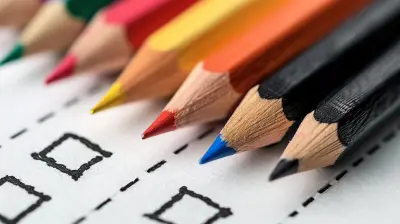19 March 2025
As educators, we're always trying to figure out better ways to help our students learn. It's not just about delivering the content anymore; it's about engaging students, understanding where they're at, and guiding them toward deeper understanding. One of the most effective tools we can use to achieve this is formative assessment.
But let's be real—assessment can feel like a burden. You might think of it as just another task to check off your endless to-do list. However, formative assessment isn't just about grading or checking if students are paying attention. It's about guiding your teaching practice, helping you tailor your lessons to meet your students' needs, and creating a more dynamic learning environment.
In this article, we'll dive deep into how formative assessment can truly inform your teaching practice. By the end, you’ll understand why it’s such a game-changer for both you and your students.

What is Formative Assessment?
Before we get too deep, let’s clarify what we mean by formative assessment. In simple terms, formative assessment is any activity that gives you feedback on your students' understanding while the learning is still happening. It’s ongoing, unlike a final exam or a big project at the end of the term.Think of formative assessment like checking the GPS on a long road trip. You don’t wait until you’ve driven 500 miles in the wrong direction to course-correct, right? Instead, you check periodically to ensure you're on the right track. Similarly, formative assessments help you and your students stay on course throughout the learning journey.
Examples of Formative Assessment
Formative assessments come in all shapes and sizes, and they don’t have to be formal. Here are a few examples:- Exit tickets: Have students write down one thing they learned and one question they still have before leaving class.
- Quick quizzes: Low-stakes quizzes that offer immediate feedback on a specific concept.
- Think-pair-share: Students think about a question, discuss with a partner, and then share with the class.
- Observation: Walking around the room and observing how students are working through a problem or discussing a topic.
- Peer review: Students give feedback on each other’s work.
The key is that these assessments provide real-time data on how well students are grasping the material. And remember, formative assessment isn’t just about testing students—it’s also about testing your teaching strategies.

Why Formative Assessment Matters
You might be wondering, "Why bother with formative assessments when I already have so much on my plate?" Well, here's the thing: formative assessment isn’t extra work. In fact, it’s a tool that can make your teaching more effective and efficient.Provides Immediate Feedback
One of the most significant benefits of formative assessment is that it gives you immediate feedback. Instead of waiting until the end of a unit to discover that half your class didn't understand a key concept, you can catch misunderstandings early. This allows you to adjust your teaching in real-time, ensuring that no student falls too far behind.Informs Instructional Decisions
Have you ever found yourself halfway through a lesson and noticed that your students' eyes are glazing over? Yeah, we’ve all been there. Formative assessments act as a reality check. They help you determine which areas need more attention and which ones you can breeze through.For instance, a quick poll or quiz can show you if students are struggling with a particular topic. If they are, you can revisit the material or try a new teaching strategy. On the flip side, if students are excelling, you can move on to new content without wasting time on what they already know.
Encourages Student Engagement
Formative assessments aren’t just for you—they’re for your students, too. When you involve students in the assessment process, they become more active participants in their learning. They start thinking critically about what they know and what they still need to work on.For example, when students complete an exit ticket, they're not just giving you feedback—they’re reflecting on their own learning. This reflection is essential for deep learning because it encourages students to take ownership of their progress.
Reduces Test Anxiety
Let’s face it, most students don’t love tests. But formative assessments are low-stakes, which means they don’t come with the same anxiety-inducing pressure as big exams. This approach creates a more relaxed environment where students can focus on learning rather than worrying about their grades.By using formative assessments regularly, you’re also preparing students for summative assessments (like final exams) in a more gradual, less stressful way. It’s like practicing for a big game—you don’t just show up on the day of the match without any preparation. You practice, get feedback, and improve along the way.

How Formative Assessment Can Inform Your Teaching Practice
Now that we’ve covered the basics, let’s get into the nitty-gritty of how formative assessment can directly inform and improve your teaching practice.1. Identifying Knowledge Gaps
One of the biggest challenges in teaching is understanding where your students are struggling. You might think they’ve grasped a concept, but when test time rolls around, it’s clear that something didn’t stick.Formative assessments provide a clear window into your students’ understanding. By regularly checking in, you can identify knowledge gaps early and address them before they become bigger problems. For example, a quick quiz or class discussion can reveal that students are confused about a particular concept. Armed with this information, you can reteach the material or provide additional resources to help them catch up.
2. Adjusting Pacing
We’ve all had lessons where we either sped through content too quickly or dragged it out for too long. Formative assessments help you find the sweet spot for pacing.For example, if a majority of your students ace a quick quiz, it’s a sign that they’re ready to move on. On the flip side, if many students struggle, it’s a red flag that you need to slow down and provide more support.
This real-time data allows you to adjust your lesson plans on the fly, ensuring that your pacing aligns with your students’ needs.
3. Personalizing Instruction
Every student is unique, and they all learn at their own pace. Formative assessments give you the data you need to personalize your instruction.For example, after conducting a formative assessment, you might notice that a few students are struggling with a particular concept while others have already mastered it. Instead of teaching the entire class the same material, you can divide students into small groups based on their needs. One group might receive additional support, while another group can work on more advanced tasks.
Personalized instruction is more effective because it meets students where they are, rather than forcing them to conform to a one-size-fits-all approach.
4. Encouraging Metacognition
Metacognition is just a fancy term for thinking about thinking. When students engage in formative assessments, they’re not only demonstrating their knowledge—they’re also reflecting on their learning process.For example, after completing a formative assessment, you can ask students to reflect on what they found challenging and how they plan to tackle those challenges moving forward. This kind of reflection encourages students to take an active role in their learning, which boosts their motivation and helps them become more self-directed learners.
5. Building a Growth Mindset
Formative assessment is all about growth. It shifts the focus from grades and performance to learning and improvement. When students receive feedback on formative assessments, they're encouraged to view mistakes as opportunities for growth, rather than failures.For example, if a student struggles with a concept on a formative quiz, they have the chance to review the material and try again. This iterative process helps them develop a growth mindset—the belief that they can improve through effort and perseverance.
As a teacher, you can foster this mindset by providing constructive feedback that focuses on the learning process, rather than just the final outcome.

Best Practices for Using Formative Assessment
Now that you understand how formative assessment can inform your teaching practice, let’s talk about how to implement it effectively.1. Keep It Simple
Formative assessments don’t need to be complicated. In fact, the simpler, the better. Quick quizzes, exit tickets, and class discussions are all easy ways to gather real-time feedback without overwhelming yourself or your students.2. Make It Regular
Formative assessment should be a regular part of your teaching practice—not just something you do once in a while. The more frequently you assess students, the more data you’ll have to inform your instruction.3. Use a Variety of Methods
Not all students learn the same way, and not all students will respond to the same type of assessment. Use a variety of formative assessment methods to get a well-rounded picture of your students’ understanding. For example, combine quizzes, discussions, peer reviews, and hands-on activities to assess different learning styles.4. Provide Timely Feedback
Feedback is only useful if it’s timely. Make sure you provide feedback on formative assessments as soon as possible, so students have the opportunity to improve before moving on to new material.5. Involve Students in the Process
Formative assessment is most effective when students take an active role in the process. Encourage students to reflect on their learning, ask questions, and seek feedback. This not only helps them learn but also fosters a sense of ownership over their education.Conclusion
Formative assessment is more than just a tool for measuring student progress—it’s a powerful way to inform your teaching practice. By regularly assessing your students' understanding, you can identify knowledge gaps, adjust your pacing, personalize instruction, and help students develop a growth mindset. And the best part? Formative assessment fosters a more engaging, dynamic learning environment where both you and your students can thrive.So, the next time you feel overwhelmed by the idea of “assessment," remember: formative assessment is your ally. It’s not about adding more to your plate—it’s about using the information you already have to teach more effectively.









Rosanna Willis
Like gentle whispers in a classroom’s embrace, formative assessment guides our path, illuminating growth and weaving wisdom into every lesson.
April 1, 2025 at 11:46 AM